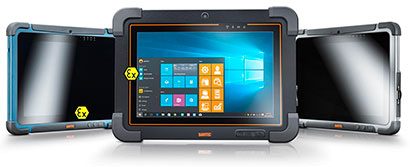
In this article we're covering an example of a very specialized and increasingly important type of industrial tablet. The BARTEC Agile X IS is certified for use in Class 1 Division 1/ATEX Zone 1 hazardous locations. That requires some explanation.
The term "hazardous location" — or "HazLoc" — originated in electrical engineering where a hazardous location is  defined as a place where concentrations of flammable gases, vapors, or dusts occur.
defined as a place where concentrations of flammable gases, vapors, or dusts occur.
Electrical equipment operating in such areas must be designed so that it does not cause ignition or explosions. Devices that fulfill that requirement are described as "intrinsically safe," which means that they are incapable of igniting such gasses, dust or vapors.
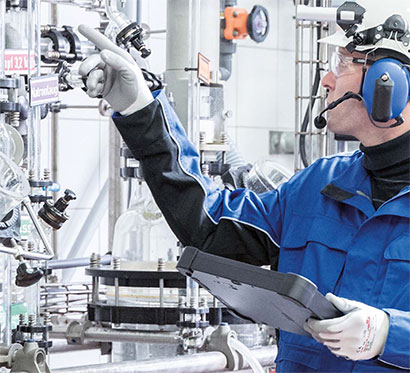
How does one go about creating a device that will not, under any circumstances, cause ignition of flammable matters of certain kinds and in certain locations? One way, the easy way, is to use an existing (or 3rd party) product and simply stick it in a box or build one around it. Problem is, that then requires re-certification every time anything changes in the underlying product, and the case makes it hard (or impossible) to use accessories.
The folks at BARTEC in Germany decided to do it the hard way. They designed a product line for use in hazardous locations from the ground up. What's involved in that? It means elimination of every possible cause of ignition. There must be no air flow over electrical parts and no connectors where friction could cause sparking. Functionality must be part of the motherboard instead of being added via modules. Popular options and accessories must be integrated into the design. That way, there's no need for re-certification whenever the hardware is upgraded.
And there are other aspects. Most locations that require the use of intrinsically safe electronic equipment are tiered. Parts of the premises are safe, others may be classified as temporarily, occasionally or permanently hazardous. Each falls into a different zone and requires different degrees of electronic safety measures. Providing devices certified for use in different HazLoc zones but using the same controls and same software reduces errors and cuts down on training time.
That all said, let's move on to BARTEC and the BARTEC hazardous location tablets. The company has been around for over 40 years. They got started making safety switches to prevent explosions at gas stations. Today they are a world leader in safety technologies with a staff of over 1,800. Their rugged 10-inch tablet PCs are available in three varieties: the standard Agile ("non-Ex"), the Zone 2-certified Agile X, and the new Zone 1-certified Agile X IS.

The image compilation below shows one inherent difference between the Zone 1 and Zone 2 versions: the more stringent Zone 1 requirements necessitate a different and more comprehensive type of enclosure. Surrounding the rear view of the Zone 1-certified Agile X IS are the four side views of both the Zone 1 and the Zone 2 versions:
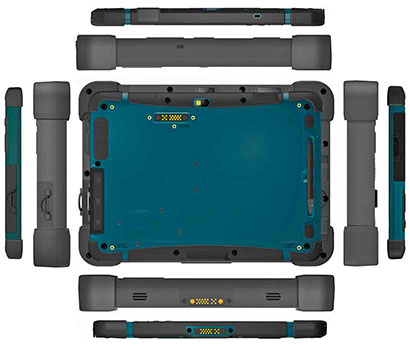
The comparison picture between the Agile X and the Agile X IS below also shows the additional protection of the Zone 1-certified version on the right.
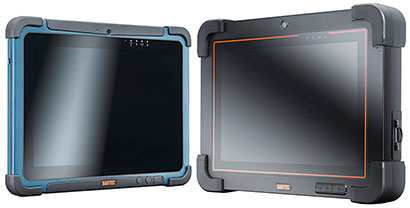
As far as the underlying tablet goes, that was developed in a partnership between BARTEC and Winmate Communications. It's a premium rugged tablet design with a very bright 10.1-inch IPS LCD whose 1920 x 1200 pixel resolution make for a 16:10 aspect ratio and 224 pixels per inch, which is about the same as the "retina" versions of the Apple MacBook Pro and the iMac 5k. There's, of course, 10-point projected capacitive multi-touch for the effortless tapping, panning, pinching and zooming everyone has gotten used to.
Processing power comes from a 14nm quad-core Intel "Braswell" Pentium N3710 CPU with a base frequency of 1.60GHz and a maximum burst frequency of 2.56GHz. This is a very power-efficient chip with a TDP of just 6 watts and a Scenario Design Power of only 4 watts (SDP is what Intel thinks the normal load of a processor will be). The chip includes Intel HD Graphics 405, which are of the same architecture as Intel's 5th generation "Broadwell" Core processors. The N3710 is not a Core chip, but it packs a considerable punch.
On the connectivity side, things are a little different as Zone 1-certified devices must not have any exposed ports or mechanisms that might spark. The Agile X IS does, however, offer a USB 2.0 port that even allows direct access with a BARTEC-certified 8GB USB storage device while operating in a Zone 1/Division 1 environment.
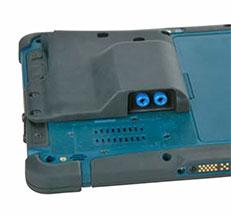 In addition, the Agile X IS has a special surface mount expansion port for use with HART add-on modules that bolt onto the tablet. HART, which stands for Highway Addressable Remote Transducer, is a bi-directional communication protocol compatible with a wide range of analog instrumentation current loops. Modules available from BARTEC currently support RFID, SIL and HART modem functionality, or can be configured to customer requirements. This way, Agile X IS tablet PCs can provide direct connectivity to field devices even in hazardous areas.
In addition, the Agile X IS has a special surface mount expansion port for use with HART add-on modules that bolt onto the tablet. HART, which stands for Highway Addressable Remote Transducer, is a bi-directional communication protocol compatible with a wide range of analog instrumentation current loops. Modules available from BARTEC currently support RFID, SIL and HART modem functionality, or can be configured to customer requirements. This way, Agile X IS tablet PCs can provide direct connectivity to field devices even in hazardous areas.
And since in hazardous locations you can't just plug the tablet in to recharge it, BARTEC offers hot-swap functionality through a secondary externally accessible battery. As of this writing, no other tablet offers hot-swapping in Zone 1/Division 1 environments.
The Agile X IS offers dual-band 802.11a/b/g/n/ac WiFi, Class 1 Bluetooth v.4.1, a 2mp front cam and a 8mp documentation camera in the rear, optional HF-RFID/NFC and an optional Zebra SE4500 1D/2D barcode imager, the latter not available in any directly competing product.
For ruggedness, solid design and corner protection mean the tablet can survive 4-foot drops to concrete even with the add-on module and battery. The operating temperature range is a wide -4° to 122°F. Ingress protection is at the IP65 level, which means the device is, of course, totally dustproof and can also handle low pressure water jets from all directions.
On the electrical safety side, a bonded double layer of protective Gorilla glass, a special battery lock and special protection for Ex circuits, and a thermal fuse that guards against overheating all ensure that electrical parts remain isolated from outside air.
In summary, this new special-purpose BARTEC tablet PC brings quite a few valuable and productivity-enhancing features to the table. There's the built-in industrial-grade scanner, hot-swappable battery power in HazLoc areas, direct USB access in Zone 1, an expansion port system and, of course, the use of Windows that enables bringing desktop and legacy Windows software directly into Zone 1 deployments.
So that's the new BARTEC Agile X IS, built in cooperation between BARTEC and Winmate, both specialists in their fields with decades' worth of global track records. It's a rugged tablet designed to meet the stringent rules and certification requirements for use in hazardous locations. That's very different from the very loosely defined term "ruggedness" where every customer can decide that's tough and rugged enough for them. For HazLoc deployments, the rules are very strict. Cutting corners not only won't do, that'd be dangerous, a liability, and quite possibly illegal.
BARTEC's official product launch November 22, 2016 at the SPS IPC DRIVES show in Nuremberg, Germany. Further information available at www.bartecmobility.com. Also see the Ex examination certificate for the Agile X IS.



